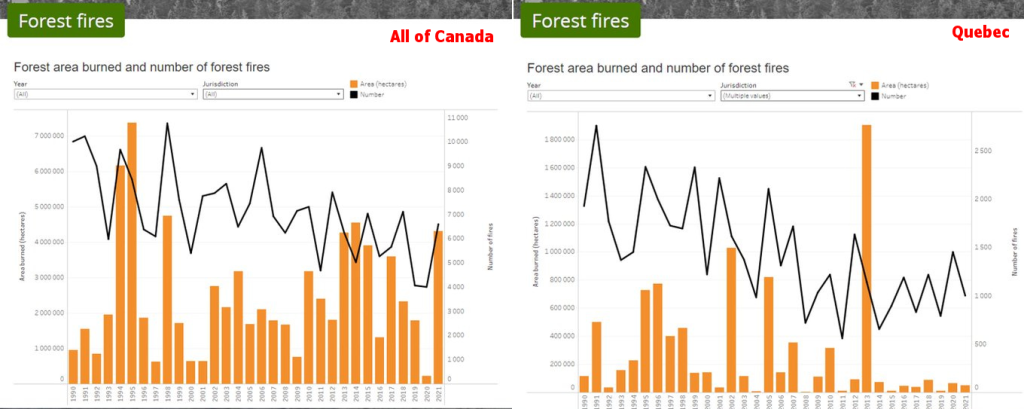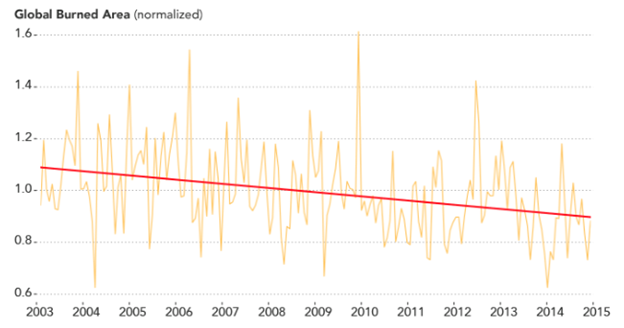Last week, mainstream media outlets were abuzz with stories claiming that smoke from wildfires in Canada visibly polluting the skies in New York City, Washington, D.C., and many other cities in the northeastern United States was due to climate change. This is false. Data and history show that wildfires in Canada have not increased number or severity, and that, driven by prevailing winds, smoke from Canada’s annual wildfire season has darkened U.S. skies multiple times in the past.
Many media outlets, including The Washington Post, The New York Times, USA Today, AXIOS, and National Geographic were quick to blame Canada’s wildfires and the smoke from them on climate change without citing any credible evidence, because none exists.
Among the media’s claims are:
As climate change dropped its calling card on the East Coast last week in the form of thick, dangerous smoke, millions of Americans and Canadians shared the jarring experience — forced to retreat indoors, cancel plans, wear masks and breathe hazardous air. – The Washington Post
Canada’s devastating fires and toxic smoke might not recur every year, but the heat from climate change increases the risks of a wide range of disasters. – The New York Times
“We’re seeing events that are unknown in the historical record,” said Robert Scheller, a professor of forestry at North Carolina State University. “It’s hard to talk about without painting a grim picture.” – USA Today
The harmful veil of smoke that enveloped the country’s economic and political power centers this week presented bankers and lawmakers with an in-your-face demonstration of what climate change looks, feels and smells like. – AXIOS
As climate change drives an increase in wildfires, we’re seeing more smoke lofted into the upper atmosphere each fire season. – National Geographic
History and real-world data disprove each and every one of these claims.
Long before anyone used fossil fuels to generate electricity or for transportation, this exact scenario happened before. For example, May 19, 1780 became known as “New England’s Dark Day” where fires in Canada caused so much smoke that candles had to be lit at midday to see.
Such “yellow days,” have also happened periodically before and since then, as recorded by the New England Historical Society (NEHS). The NEHS reports smoke from Canadian wildfires created “yellow” or “dark,” days in the eastern United States on May 12, 1706; October. 21, 1716; August, 9 1732; May 19, 1780; July 3, 1814; November, 6-10, 1819; July 8, 1836; September. 2, 1894; and September 24-30, 1950.
Data presented in Climate at a Glance: U.S. Wildfires shows that compared to the first half of the twentieth century, the number of wildfires occurring in the United States over the past decade are significantly lower, and the fires have been less severe. Even in the worst wildfire seasons occurring recently, wildfires typically burned one-fifth to half as much land as many wildfire seasons during the early twentieth century, and much less the average acreage burned in previous centuries.
The same is true in Canada, where, this week, the mainstream media seemingly discovered wildfires occur and produce smoke. Data from Canada’s National Forestry Database for both the entire country as well as the province of Quebec, where many of the recent wildfires occurred, show declining trends for both the number of fires and area burned over the past 31 years, as seen in Figure 1, below:

Indeed, a study by scientists with the Canadian Forest Service attributed the decline in forest fires in Canada over the past few decades to the combined effect of carbon dioxide fertilization and modestly rising temperatures, which resulted in improved soil moisture conditions. Because plants lose less water via the process of transpiration under conditions of high CO2 and higher temperatures, less moisture is drawn from soil.
Globally, NASA has recorded a significant decline in the number of wildfires. In Researchers Detect a Global Drop in Fires, NASA reported “Globally, the total acreage burned by fires declined 24 percent between 1998 and 2015, according to a new paper published in Science.” (See Figure 2, below)

Clearly, if “global warming” aka “climate change” was affecting wildfire trends, it would show up somewhere in the real-world-data. This evidence factually disproves any claim that the Earth’s mild warming trend is increasing the number of wildfires or making more severe wildfires.
The media likes to blame climate change for enhancing or even creating the fires, but climate scientist Roger Pielke Jr. PhD., had this to say about the Canadian fire outbreak in What the media won’t tell you about … Wildfires.
“Looking at data from the NFDP, we can see that the majority of fires in Quebec and the area that they burn over the past decade are caused by humans, with the balance caused by lightning…,” Pielke, Jr. wrote.
He added that the Intergovernmental Panel on Climate Change (IPCC) has found no evidence of a “climate signal” in wildfire data, and that the fire outbreak was due to a combination of non-climatic events:
In short, the IPCC does not provide a basis for strong claims of detection or attribution of “fire weather” to climate change. The IPCC is silent on trends in fire numbers and area burned. These conclusions are contrary to almost all media reporting.
…
But the disaster was caused by a combination of a wind storm, managed open space with invasive species, a rainfall deficit, decades of land use decisions that placed neighborhoods alongside combustible lands, homes build of flammable materials and more. Sure, say that climate change played a role if that suits, but after that is said, a far more important discussion has to happen about development, building codes. land use and management, open space, prescribed burns and so on.
In summary, Pielke said the following:
-
- The IPCC has not detected or attributed fire occurrence or area burned to human-caused climate change
- Globally, emissions from wildfires has decreased globally over recent decades, as well as in many regions
- Canada wildfire trends show no increase in recent decades
- Wildfires used to be much more extensive in past centuries
- Wildfires are a part of the natural eco-system.
The bottom line? The mainstream media rushed to attribute Canada’s wildfires and the smoke they delivered to the U.S. East Coast to climate change. The truth is the wildfires were natural, and the smoke in the United States was a result of wind currents and temporary weather conditions, including a “slow-moving, low-pressure system off the northeast coast,”
No evidence supports attributing either phenomenon to climate change. Shame on the media for promoting the the narrative of “climate change makes everything worse,” at the expense of the truth in the form of readily available data and historical records.

















